Understanding what your competitors are doing online is no longer optional, it’s a necessity. Search engines are crowded, and businesses that fail to adapt quickly get left behind. One of the smartest ways to stay ahead is through competitor keyword analysis, a core part of professional SEO services. By studying the exact keywords your rivals rank for, you can discover hidden opportunities and refine your own strategy. This blog breaks down everything you need to know, from tools to step-by-step methods, so you can start outranking competitors and capturing more leads.
Key Takeaways
- Competitor keyword analysis shows you the exact terms driving traffic to your rivals.
- It helps you uncover keyword gaps and opportunities you may be missing.
- Tools like Ahrefs, Semrush, and SpyFu simplify the process and reveal valuable insights.
- A structured approach ensures you focus on high-impact, intent-driven keywords.
- Done consistently, competitor keyword analysis boosts visibility, authority, and lead generation.
What Is Keyword Competitor Analysis?
Keyword competitor analysis is the process of studying which keywords are bringing traffic to your competitors’ websites and how they’re using them to rank in search results. Unlike basic keyword research, this approach gives you context—you can see what’s actually working in your niche. It goes beyond volumes and difficulty to show the competitive landscape. By identifying gaps, overlaps, and hidden opportunities, you gain a practical advantage. When done correctly, competitor analysis allows you to prioritize keywords with proven success while avoiding wasted effort on terms that don’t deliver results.
To make competitor keyword analysis effective, it’s important to understand the different types of keywords you’ll encounter:
- Transactional Keywords – High-intent terms where users are ready to buy or take action (e.g., buy SEO software, order pizza online).
- Navigational Keywords – Searches aimed at finding a specific brand, product, or website (e.g., Ahrefs login, Nike shoes site).
- Informational Keywords – Queries focused on learning, guides, or how-to content (e.g., how to do competitor analysis, what is SEO).
- Commercial Keywords – Keywords used when users are comparing options before purchase (e.g., best SEO tools 2025, Ahrefs vs Semrush).
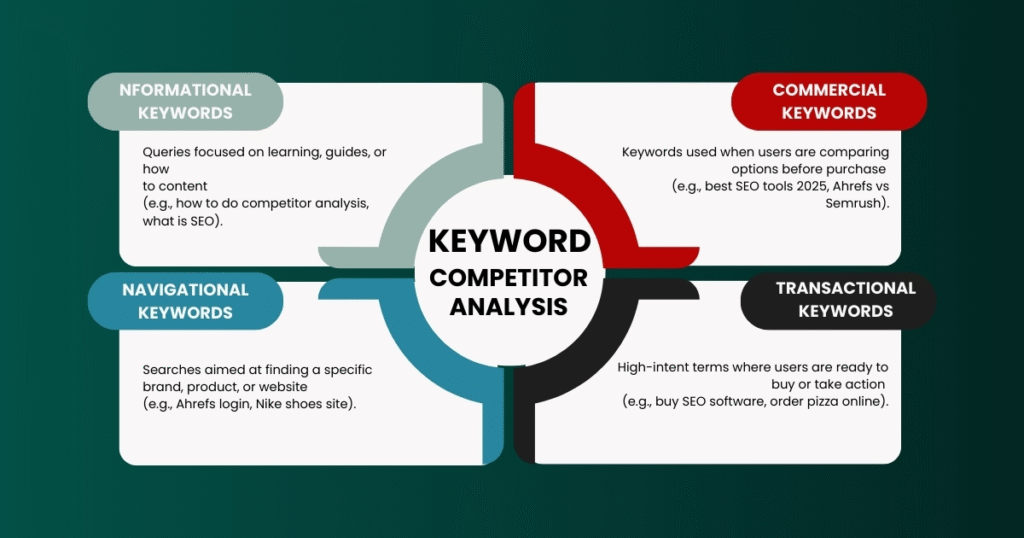
By categorizing competitor keywords into these groups, you can better prioritize which ones align with your goals—whether it’s generating sales, building brand visibility, or driving educational traffic.
Why You Need to Do Keyword Research and Competitor Analysis
Many businesses rely on standard keyword research but miss the bigger picture. Competitor keyword analysis shows you how real competitors are using keywords in their strategies. It helps uncover the content types, traffic drivers, and intent-focused keywords you may not think of. By monitoring your competitors, you can spot trends early and adapt before falling behind. You’ll also discover keyword gaps that your competitors rank for but you don’t, giving you opportunities to win traffic. Most importantly, this process ensures your SEO strategy is based on data-driven insights instead of assumptions, leading to better ROI.
Key Benefits of Competitor Keyword Analysis
- Reveals hidden opportunities by showing keywords your rivals rank for that you’ve missed.
- Highlights search intent so you understand whether users are looking to buy, learn, or compare.
- Uncovers content formats that perform best in your niche, such as guides, reviews, or videos.
- Keeps you ahead of trends by tracking new keywords competitors start ranking for.
- Improves ROI by focusing efforts on proven, high-performing keywords instead of guesswork.
Tools for Keyword Competitive Analysis
When it comes to analyzing competitor keywords, the right tools make all the difference. They allow you to see not only which keywords competitors rank for but also how they use them to drive traffic and conversions. Each tool comes with unique strengths, some focus on content ideas, others on keyword rankings, and some on traffic analytics. Using a mix of these tools will give you the most complete picture of your competitors’ strategies.
Ubersuggest
Ubersuggest is a beginner-friendly SEO tool created by Neil Patel. It provides keyword suggestions, search volume, and difficulty levels while showing competitor data. With Ubersuggest, you can analyze your competitors’ top pages, discover the keywords driving them traffic, and uncover backlink opportunities. Its simple dashboard makes it great for small businesses starting out. It also highlights keyword gaps, meaning you can easily spot terms your rivals rank for but you don’t. For competitor keyword analysis, it’s a low-cost, easy-to-use option that gives a clear overview of opportunities.

AnswerThePublic
AnswerThePublic focuses on content ideas and user intent. It generates a “visual keyword map” based on the questions people ask around your keyword. For competitor analysis, this helps you understand the types of queries competitors may already be targeting. By comparing your content against theirs, you can find missing angles and create better answers. This tool is especially useful for content marketers aiming to outperform competitors in informational and long-tail queries. It complements other keyword tools by showing not just what people search for, but how they phrase their searches.
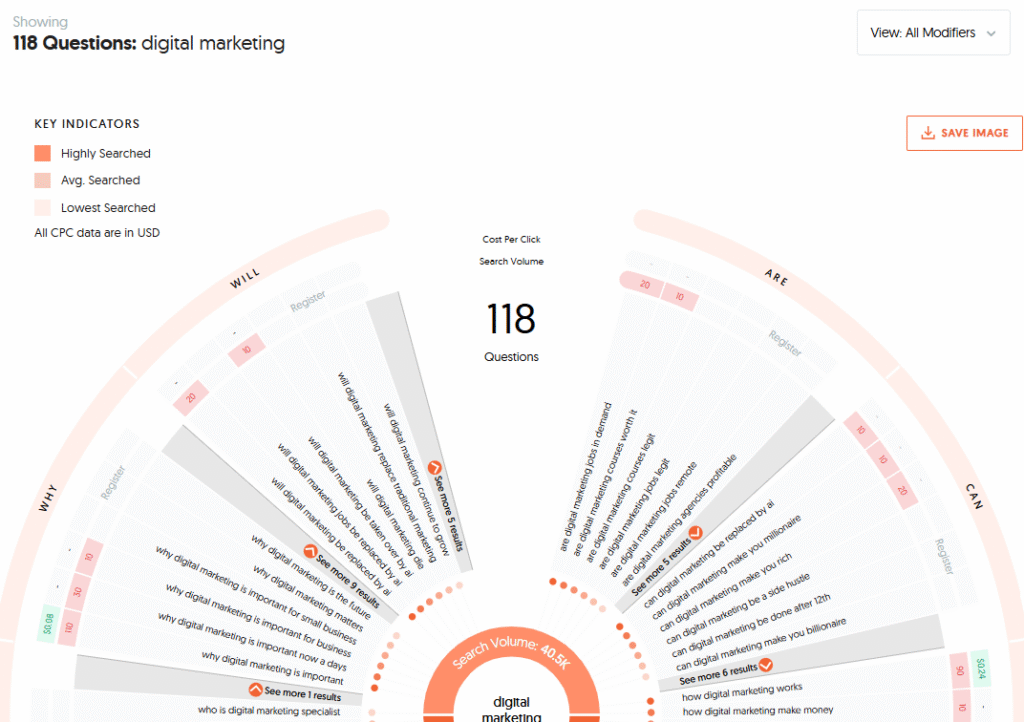
BuzzSumo
BuzzSumo is designed to analyze competitor content performance. It shows you which articles, blogs, and posts get the most shares, backlinks, and engagement. When paired with keyword analysis, it reveals what kind of content competitors are creating around specific keywords and how well it performs. This helps you craft content that isn’t just optimized for search but also share-worthy. BuzzSumo also highlights influencers in your niche who amplify keyword-driven content, making it easier to combine SEO with social visibility. It’s perfect for discovering content opportunities that go beyond ranking.

SpyFu
SpyFu specializes in competitor keyword history. It shows both organic and paid keywords your competitors are targeting. For SEO, you can analyze organic rankings to see which keywords bring consistent traffic. For PPC, you can uncover where competitors are investing money, which signals keyword value. SpyFu also lets you track keyword rankings over time, so you can identify trends and shifts in competitor focus. This long-term data helps you prioritize sustainable keywords and avoid chasing short-term fads. It’s particularly useful for competitive niches where keyword competition is high.

Ahrefs
Ahrefs is one of the most powerful all-in-one SEO tools. Its Site Explorer and Content Gap features allow you to enter competitor domains and immediately see which keywords they rank for that you don’t. It also shows traffic estimates, backlinks, and keyword movement. With Ahrefs, you can identify opportunities to outrank competitors by improving content quality or targeting underused keywords. Its backlink data is also unmatched, letting you see which keywords are supported by strong link profiles. For in-depth competitor keyword analysis, Ahrefs is considered an industry standard.
Semrush
Semrush is another leading SEO platform with comprehensive competitor keyword analysis features. Its Domain Overview shows keyword rankings, traffic estimates, and distribution by country. The Keyword Gap tool lets you directly compare your site with multiple competitors at once, making it easy to spot opportunities. Semrush also integrates PPC data, showing how competitors are using keywords across both organic and paid campaigns. For businesses seeking detailed insights into competitor strategies, Semrush provides everything in one place. It’s especially effective for agencies or brands that need advanced reporting and scalability.
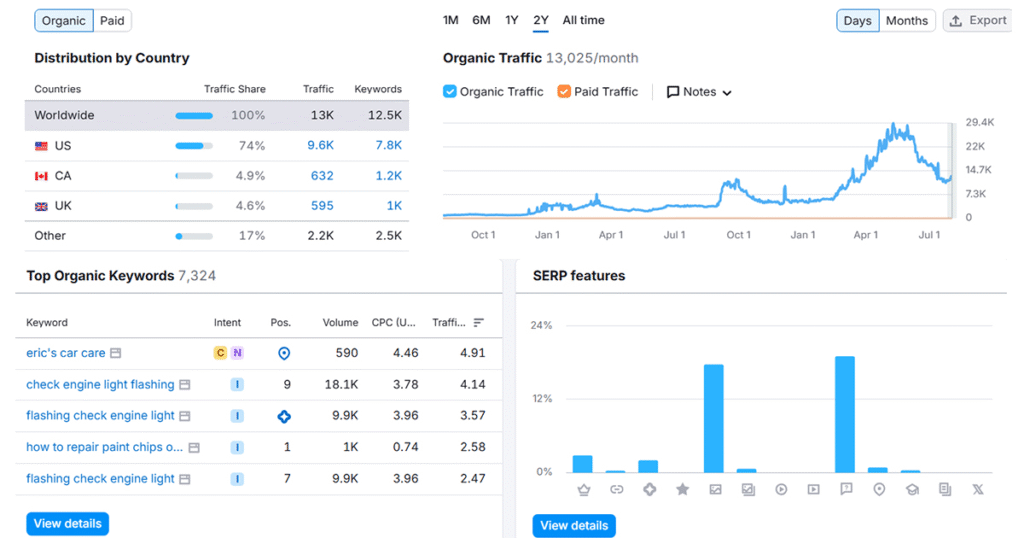
SimilarWeb
SimilarWeb is best known for its traffic analytics, but it also provides keyword-level insights. It shows you where competitors’ traffic comes from—search, social, referral, or paid. For competitor keyword analysis, this helps you understand which keywords are driving actual traffic versus just rankings. You can benchmark your traffic sources against competitors and prioritize keywords based on real-world performance. SimilarWeb is great for a high-level market overview, making it ideal for strategic planning and spotting broader keyword trends.
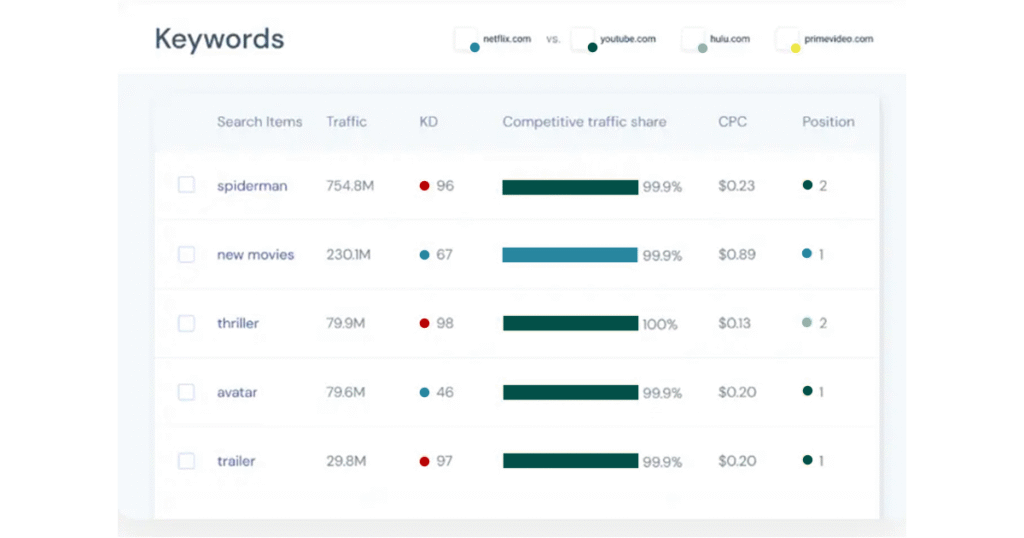
Pro Rank Tracker
Pro Rank Tracker is focused on monitoring keyword positions across search engines. While it doesn’t generate new keyword ideas, it tracks how competitor rankings shift over time. This is valuable because you can see when a competitor suddenly climbs for a keyword and investigate why. You’ll also know when they lose positions, giving you a chance to step in. By tracking competitor movement, Pro Rank Tracker ensures you don’t miss important keyword trends. It’s a great complement to research-focused tools like Ahrefs and Semrush.
MozBar
MozBar is a free Chrome extension that gives quick SEO insights on competitor websites. It shows metrics like Domain Authority and Page Authority, which help you assess keyword competitiveness. For competitor keyword analysis, MozBar lets you evaluate SERPs instantly. You can see which competitors dominate for a keyword and estimate how strong they are. It’s not as deep as paid tools, but for fast checks, it’s very effective. Combined with other platforms, MozBar helps validate whether a keyword is worth targeting based on competitor strength.
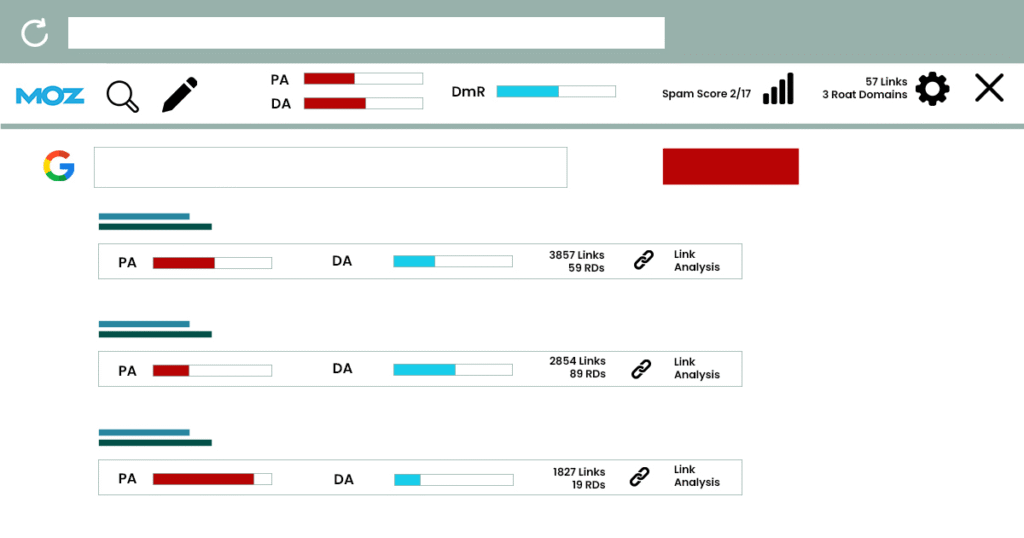
How to Do Competitor Keyword Analysis
Competitor keyword analysis helps you uncover the exact search terms driving traffic to rival websites. By studying their rankings, you can spot gaps and opportunities for your own strategy.
This process ensures your SEO efforts focus on keywords with the best potential ROI.
1. Find Your Competitors
The first step is identifying which websites you’re really competing with in search results. These aren’t always the same businesses you compete with in real life.
- Search for target keywords: Enter your primary keywords into Google and note the domains that consistently rank in the top 10 results.
- Look beyond direct competitors: A blog or resource site might compete with you in search visibility, even if they don’t sell your product.
- Use SEO tools: Tools like Ahrefs, Semrush, and Moz can generate a list of top organic competitors based on keyword overlap.
- Check industry directories and review sites: Sometimes, aggregators like Yelp or niche-specific directories rank higher than businesses.
- Goal: Build a list of at least 5–10 key competitors whose rankings you want to monitor and analyze.
2. Identify Potential Competitor Keywords
Once competitors are identified, uncover which keywords drive traffic to their site.
- Extract ranking keywords: Use tools like Ahrefs’ Site Explorer or Semrush’s Organic Research to pull a full keyword list.
- Focus on top pages: Analyze competitor pages with the highest traffic—they often reveal money-making keywords.
- Check keyword metrics: Pay attention to:
- Search Volume: How many people search for the keyword monthly.
- Keyword Difficulty (KD): How hard it is to rank for the keyword.
- Traffic Potential: Estimate of how much traffic you could realistically gain.
- CPC (Cost Per Click): Indicates commercial value and competitiveness.
- Search Volume: How many people search for the keyword monthly.
- Understand user intent: Classify keywords into informational, navigational, commercial, or transactional categories.
- Look for keyword gaps: Identify terms your competitors rank for but you don’t. These are quick-win opportunities.
3. Choose Competitor Keywords to Target
After building a list, refine it to find the keywords most valuable for your SEO strategy.
- Filter by relevance: Only keep keywords that directly align with your products, services, or target audience.
- Evaluate competition: Avoid overly competitive head terms unless you have a strong domain authority.
- Target long-tail keywords: Focus on 3–5 word phrases with clear intent—these often bring in more qualified traffic.
- Prioritize intent-driven keywords: For example, “best running shoes for flat feet” shows higher purchase intent than just “running shoes.”
- Check conversion potential: Focus on keywords that attract leads likely to convert into customers.
- Balance short-term and long-term:
- Short-term wins: Low-competition, moderate-traffic keywords.
- Long-term growth: Higher-competition keywords you can build authority for over time.
- Short-term wins: Low-competition, moderate-traffic keywords.
- Finalize your list: Create a tiered keyword strategy (e.g., High Priority, Medium Priority, Low Priority) to guide content creation.
Tips for Analyzing Competitive Content
Analyzing competitor keywords is only half the battle—you also need to study their content. Look at how competitors structure their posts, the formats they use, and how in-depth their coverage is. Check whether they target informational or transactional intent. Evaluate their use of headings, internal links, and media. This helps you identify gaps in quality or detail where your content can outperform theirs. The goal is not to copy but to create something more comprehensive, valuable, and user-friendly.
Lead Generation with Maddex SEO Services
At The Maddex, we go beyond keyword research—we specialize in full-scale SEO competitor analysis to give your business an edge. Our team uses advanced tools and proven frameworks to uncover hidden opportunities, identify keyword gaps, and craft strategies that drive real results. Whether your goal is higher rankings, more organic traffic, or turning visitors into paying customers, we deliver tailored solutions. With data-driven SEO and lead generation expertise, Maddex ensures your brand rises above competitors.
Partner with Maddex today and start turning competitor insights into business growth.



